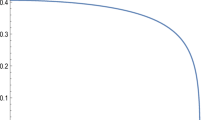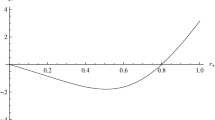Abstract
Using the definition of a black hole’s volume introduced by Christodoulou and Rovelli, we calculate the interior volume of a (2 + 1)-dimensional charged Banados Teitelboim Zanelli (BTZ) black hole, and find that the volume increases linearly with time. Afterwards, the entropy of a massless scalar field inside the black hole is calculated and the result indicates that the entropy will be also increasing with time infinitely. Moreover, thinking about Hawking radiation, the ratio of variation of the scalar field’s entropy to the variation of Bekenstein–Hawking entropy is approximately a linear function of m, which is quite different from a RN black hole while m is relatively large. In the end, we extend the calculation above to a massive BTZ black hole and find that the relationship with different \(\tilde {M}\) between two kinds of entropy is similar to the previous result. But the difference is that the relationship function \(F(m,q,\tilde {M})\) will tend to be a constant when the mass parameter \(\tilde {M}\) becomes big enough.


Similar content being viewed by others
References
Christodoulou, M., Rovelli, C.: Phys. Rev. D 91 (6), 064046 (2015). https://doi.org/10.1103/PhysRevD.91.064046. arXiv:1411.2854[gr-qc]
Bhaumik, N., Majhi, B.R.: Int. J. Mod. Phys. A 33 (02), 1850011 (2018). https://doi.org/10.1142/S0217751X18500112. arXiv:1607.03704[gr-qc]
Bengtsson, I., Jakobsson, E.: Mod. Phys. Lett. A 30(21), 1550103 (2015). https://doi.org/10.1142/S0217732315501035. arXiv:1502.01907[gr-qc]
Wang, X.Y., Liu, W.B.: Phys. Lett. B 788, 464 (2019). https://doi.org/10.1016/j.physletb.2018.11.056
Wang, X.Y., Jiang, J., Liu, W.B.: Class. Quant. Grav. 35(21), 215002 (2018). https://doi.org/10.1088/1361-6382/aae276. arXiv:1803.09649[gr-qc]
Banados, M., Teitelboim, C., Zanelli, J.: Phys. Rev. Lett. 69, 1849 (1992). https://doi.org/10.1103/PhysRevLett.69.1849. arXiv:hep-th/9204099
Banados, M., Henneaux, M., Teitelboim, C., Zanelli, J.: Phys. Rev. D 48, 1506 (1993). Erratum: [Phys. Rev. D 88 (2013) 069902] https://doi.org/10.1103/PhysRevD.48.1506, https://doi.org/10.1103/PhysRevD.88.069902. arXiv:gr-qc/9302012
Zhang, M.: Phys. Lett. B 790, 205 (2019). https://doi.org/10.1016/j.physletb.2019.01.032. arXiv:1901.04128[gr-qc]
Zhang, B.: Phys. Rev. D 92, 081501 (2015). https://doi.org/10.1103/PhysRevD.92.081501. arXiv:1510.002182[gr-qc]
Wang, X.Y., Liu, W.B.: Nucl. Phys. B 943, 114614 (2019). https://doi.org/10.1016/j.nuclphysb.2019.114614
Han, S.Z., Yang, J.Z., Wang, X.Y., Liu, W.B.: Int. J. Theor. Phys. 57 (11), 3429 (2018). https://doi.org/10.1007/s10773-018-3856-6
Majhi, B.R., Samanta, S.: Phys. Lett. B 770, 314 (2017). https://doi.org/10.1016/j.physletb.2017.05.003. arXiv:1703.00142[gr-qc]
Zhang, B.: Phys. Lett. B 773, 644 (2017). https://doi.org/10.1016/j.physletb.2017.09.035. arXiv:1709.07275[gr-qc]
Yang, J.Z., Liu, W.B.: Phys. Lett. B 782, 372 (2018). https://doi.org/10.1016/j.physletb.2018.05.050
Ali, S., Wang, X.Y., Liu, W.B.: Int. J. Mod. Phys. A 33(27), 1850159 (2018). https://doi.org/10.1142/S0217751X18501592
Cadoni, M., Setare, M.R.: JHEP 0807, 131 (2008). https://doi.org/10.1088/1126-6708/2008/07/131. arXiv:0806.2754[hep-th]
Martinez, C., Teitelboim, C., Zanelli, J.: Phys. Rev. D 61, 104013 (2000). https://doi.org/10.1103/PhysRevD.61.104013. arXiv:hep-th/9912259
Hendi, S.H., Eslam Panah, B., Panahiyan, S.: JHEP 1605, 029 (2016). https://doi.org/10.1007/JHEP05(2016)029. arXiv:1604.00370[hep-th]
Hiscock, W.A., Weems, L.D.: Phys. Rev. D 41, 1142 (1990). https://doi.org/10.1103/PhysRevD.41.1142
Acknowledgements
This work is supported by the National Natural Science Foundation of China (Grant No. 11235003).
Author information
Authors and Affiliations
Corresponding author
Additional information
Publisher’s Note
Springer Nature remains neutral with regard to jurisdictional claims in published maps and institutional affiliations.
Appendix: Lambert W Function
Appendix: Lambert W Function
Lambert W Function represented by W(x), which is also called product log function, is the inverse funtion of f(w) = wew, in which w can be any complex number. Lambert W Function is a multivalued function, and has infinite branches which are usually represented by Wk(x)(k = 0, ±1, ± 2, ± 3, ⋯ ), where Wk(x) denotes the k th branch. Every branch is a single value function. When x is a real number, there are only two branches, W0(x) and W− 1(x), which have been ploted in Fig. 3. We can find that the domain of them respectively are \([-\frac {1}{e},+\infty )\) and \([-\frac {1}{e},0)\). According to (4), \(-\frac {1}{q^{2}} e^{-\frac {m}{q^{2}}}\) is a negetive real number. So for given m and q, there are only two values of W(x), among which the smaller one corresponds to r+ and the bigger one corresponds to r−. Obviously, only when
we have r− = r+, which is the sign of the extreme BTZ black hole [17]. Besides, (30) can also be verifed by TH = 0.
Now we want to talk about the behavior of r± when q = 0. Setting \(x=-\frac {m}{q^{2}}\), (4) turns to
Unfortunately, q = 0 is a singularity. So let \(q\rightarrow 0\), i.e. \(x\rightarrow -\infty \), we have
which is just the result obtained in Ref. [8] for the case of a bare BTZ black hole with q = 0, J = 0.
Rights and permissions
About this article
Cite this article
Ali, S., Wen, P. & Liu, WB. Entropy Variation of a Charged (2 + 1)-Dimensional BTZ Black Hole Under Hawking Radiation. Int J Theor Phys 59, 1206–1213 (2020). https://doi.org/10.1007/s10773-020-04400-9
Received:
Accepted:
Published:
Issue Date:
DOI: https://doi.org/10.1007/s10773-020-04400-9





